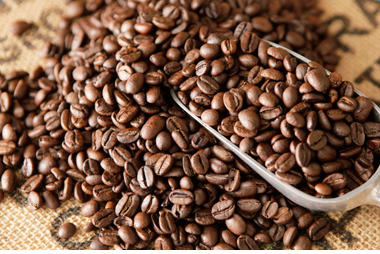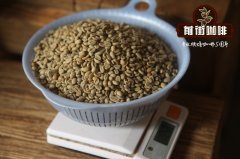Coffee roasting process? What is the principle of coffee baking?

Professional coffee knowledge exchange more coffee bean information please follow the coffee workshop (Wechat official account cafe_style)
Roasted coffee transforms the chemical and physical properties of raw coffee beans into roasted coffee products. The roasting process causes raw beans to expand and change their color, taste, smell and density, resulting in the special flavor of coffee. Unroasted coffee beans and roasted coffee beans contain similar acidity, protein and caffeine, but lack their good taste. The process needs to be hot enough to accelerate Maillard's reaction with other chemical reactions that add flavor.
As raw coffee beans are much more stable than roasted coffee beans, the roasting process tends to take place near the consumer market. This reduces the delivery time of roasted coffee beans and maximizes the shelf life of coffee beans. The vast majority of coffee beans are roasted commercially on a large scale, but some coffee drinkers bake their own beans in order to accurately control their freshness and taste.
★ coffee roasting stage
Steaming stage: 00-10 minutes; free beans-140C ° This is the most important process of the endothermic reaction of coffee beans, at this stage, the beans will slowly expand, the color will change from green to white, and the moisture will slowly evaporate from the heart of the beans because of the heat absorption of the beans. Whether the coffee tastes good or not depends on this stage, when the water evaporates too quickly, it is easy to cause the bean heart to be unripe, the beans easy to be bitter, and when the water evaporates too slowly, it will cause the coffee to taste insipid. The aroma is not rich. Therefore, we insist that the steaming process must not be omitted, and we should also use this process to make the coffee more fragrant, stronger and tastier.
Dehydration stage (before explosion): 10-15 minutes; 140-180C °; at the end of steaming, the coffee beans will change from white to yellowish light brown, when the coffee beans will continue to absorb heat to reach an explosion, and the coffee beans will expand from steaming to shrink dehydration. At this time, the moisture of the coffee beans will decrease rapidly, and when the heat absorption reaches the extreme point of the coffee itself, there will be an explosive reaction, which is called an explosion.
The first explosion stage (before the end of the first explosion): 15-18 minutes; 180-210 C °; after the first explosion, the coffee bean will begin to give back exactly the right heat you gave it, showing a perfect exothermic reaction, and then we can obviously smell it. The aroma of coffee will change from grass to coffee coke, and with the progress of the explosion, the coffee beans will burst and expand. From this time to the time when the coffee is charred, basically all the coffee can be drunk without the taste of grass, but the coffee at the beginning of the explosion will be very sour and not bitter. With the passage of time, the taste of coffee will turn into non-sour and extremely bitter. Generally speaking, the bean point will be determined by the flavor of the coffee itself. when the sour taste is fast and the bitter taste is about to appear, this is usually the bean spot. At this time, the sweetness of the coffee under the beans will reach its peak, and the flavor will be optimized. This point depends on the flavor of the coffee itself. due to the difference in growth environment, climate, soil, and moisture, the flavor of coffee will be slightly different. In this link, we should keep this point within our ideal range and keep it stable.
Second explosion stage: 18-20 minutes; 210 mi C °under the bean After the first burst, the coffee bean will slowly mature and emit a charming aroma, and when the heat absorption reaches the second peak again, the coffee bean will have a second explosion, the so-called second explosion, which will open up a space in the heart of the epidermis, and the carbon dioxide in the coffee bean will continue to be discharged, causing the internal temperature to rise continuously, start coking, turn into oil, and ooze out of the coffee surface. At this time, the coffee flavor will be bitter, strong flavor, usually Starbucks is baked to this stage, and then continue, the coffee beans will slowly turn into coke, except for the bitter taste without any flavor. This kind of coffee is lifeless, and this is a perfect performance of coffee beans.
Please note: when baking raw beans, the amount should be moderate, such as too much (not cooked), too little (will be too scorched).
In addition, Brazil and Java and other less heat-resistant beans, the first explosion and the second explosion came earlier, the heat control should pay special attention.
Analysis of ★ Baking
Through roasting, raw coffee beans can release the special aroma of coffee. Each coffee bean contains its fragrance, sour taste, sweetness and bitterness. How to release it incisively and vividly is to observe the heat of its baking, from the insipid raw beans to the mellow aftertaste in the cup. Roasting-it is a very important step for each coffee bean to outline its character and nurture fragrance during its long journey.
Coffee roasting analysis of coffee beans in this event is about 10 to 20 minutes long (inversely proportional to the temperature), and the temperature is as high as more than 200 degrees Celsius. In the process of dialogue with the hot cut, it has undergone many chemical changes, resulting in a primary explosion, a secondary explosion, a sound like popcorn, and loss of moisture. From raw beans, light roasting, medium roasting to deep roasting, the water is released again and again, the weight is reduced, but the volume slowly expands, the color of the coffee beans deepens, the fragrant oil is gradually released, and the texture becomes crisp. In raw beans, there is a lot of chloric acid, which gradually disappears with the baking process, releasing familiar and pleasant fruit acids, such as acetic acid, citric acid and malic acid in wine. Baking is just right to present these beautiful sour taste in moderation.
★ shallow Bake:
When the beans make the first light sound, the volume expands at the same time, and the color changes to a delicious cinnamon color. Acidity dominates the flavor of shallow roasted beans, texture and taste have not been brought into full play, generally used as canned coffee.
Bake in ★:
The coffee beans show an elegant brown. This method of baking is also called city roast. Medium roasting can not only preserve the original flavor of coffee beans, but also moderately release aroma, so the blue mountains of Jamaica, Colombia, Brazil and other individual coffee, more choose this roasting method. At 20 minutes, the oil begins to surface, and the beans are burned into an oily dark brown, called full-city roast, when the sour, sweet and bitter taste of coffee reaches the perfect balance, and the character of coffee beans is clearly depicted.
★ Deep Bake:
The darker the color of the coffee beans, the sweeter the flavor, when the oil has turned into caramel, bitter back to sweet, endless aftertaste, the most suitable for brewing strong Italian espresso Espresso style coffee, so it is also called Italian roasting. Moderate roasting gives life to the coffee beans and turns them into intriguing sweetness and bitterness. People who are sensitive to caffeine might as well choose deep-roasted beans, because in the process of deep-roasting, caffeine will slowly escape, so the deeper the roasted beans, the lower the caffeine content, and the caffeine content in a cup of espresso is only half that of other medium-roasted coffees. generally espresso has less caffeine and much higher caffeine if it is equal to the capacity of ordinary coffee.
Relationship between ★ roasting and caffeine
The main source of caffeine in the world is coffee beans (seeds of coffee trees). The variety of coffee beans and the method of making coffee are closely related to the caffeine content, and even the caffeine content of coffee beans in the same tree is very different. Deep-roasted coffee generally contains less caffeine than light-roasted coffee because the roasting process reduces the caffeine content in coffee beans.
Baking time, baking degree and baking method should have some influence on the removal of caffeine. Caffeine can change from solid (liquid) to gas (caffeine boiling point 178 °C) in high heat, so:
First, the longer the baking time, the more caffeine will be destroyed.
Second, deep-roasted coffee generally contains less caffeine than light-roasted coffee, because the temperature and time of roasting can reduce the caffeine in coffee beans.
Third, when baking, open the air door at the right time to discharge the gas containing caffeine in the baking room.
Important Notice :
前街咖啡 FrontStreet Coffee has moved to new addredd:
FrontStreet Coffee Address: 315,Donghua East Road,GuangZhou
Tel:020 38364473
- Prev

What is hand web baking? What do you need to pay attention to in hand web baking?
Professional coffee knowledge exchange more coffee bean information please follow the coffee workshop (Wechat official account cafe_style) hand network, also known as manual roaster, hand network roasting can enjoy the fun of baking, is the introduction to orthodox mechanical baking. The biggest advantage of hand net baking is that it can remove the smoke. if the smoke is not removed, the coffee will have a smoky smell. Hand net baking doesn't seem to be
- Next

Things are precious when they are rare? Is microbatch really good or just a gimmick? What are the selection criteria?
For the exchange of professional baristas, please pay attention to the coffee workshop (Wechat official account cafe_style) what is the micro batch, that is, in a batch of beans that have already performed well, and then further select the beans with the best performance. In the simplest words, it is in a batch of beans that have already performed well, and then further select the beans with the best performance.
Related
- Beginners will see the "Coffee pull flower" guide!
- What is the difference between ice blog purified milk and ordinary milk coffee?
- Why is the Philippines the largest producer of crops in Liberia?
- For coffee extraction, should the fine powder be retained?
- How does extracted espresso fill pressed powder? How much strength does it take to press the powder?
- How to make jasmine cold extract coffee? Is the jasmine + latte good?
- Will this little toy really make the coffee taste better? How does Lily Drip affect coffee extraction?
- Will the action of slapping the filter cup also affect coffee extraction?
- What's the difference between powder-to-water ratio and powder-to-liquid ratio?
- What is the Ethiopian local species? What does it have to do with Heirloom native species?

